How To Set Up A Sump For Saltwater Aquarium
At some point during your enquiry into aquariums, this thing called a 'Sump' may have kept popping upwardly and I recollect thinking 'What the heck is that' when I first heard nearly them. My idea of a sump was something that sits under my house to stop the basement flooding! How did that have whatever connectedness to an aquarium?
An aquarium sump is an boosted tank or vessel that is usually installed in the aquarium stand. Water moves from the aquarium to the sump and dorsum. Sumps provide additional infinite for installing filtration equipment out of sight and increase water volume to assist maintain h2o stability.
When selecting your side by side aquarium a sump can exist a very beneficial improver to both a freshwater and saltwater tank so let's go and look at the sump and discuss why you should really expect at getting a tank with 1!
Contents – Click To Leap To That Section
- What is an Aquarium Sump?
- How Do Sumps Work?
- Aquarium Sump Sections
- Types of Aquarium Sump Blueprint
- Where to Install an Aquarium Sump?
- Flow Charge per unit Through Sump
- Sump Installation Precautions
- Aquarium Sump Vs Canister Filter
What Is An Aquarium Sump?
In its most basic course, a sump is an additional tank, vessel, or container that sits outside of the aquarium. The sump tin can be a simple unmarried sleeping accommodation container or a purpose-built tank with multiple chambers that each accept a specific purpose.
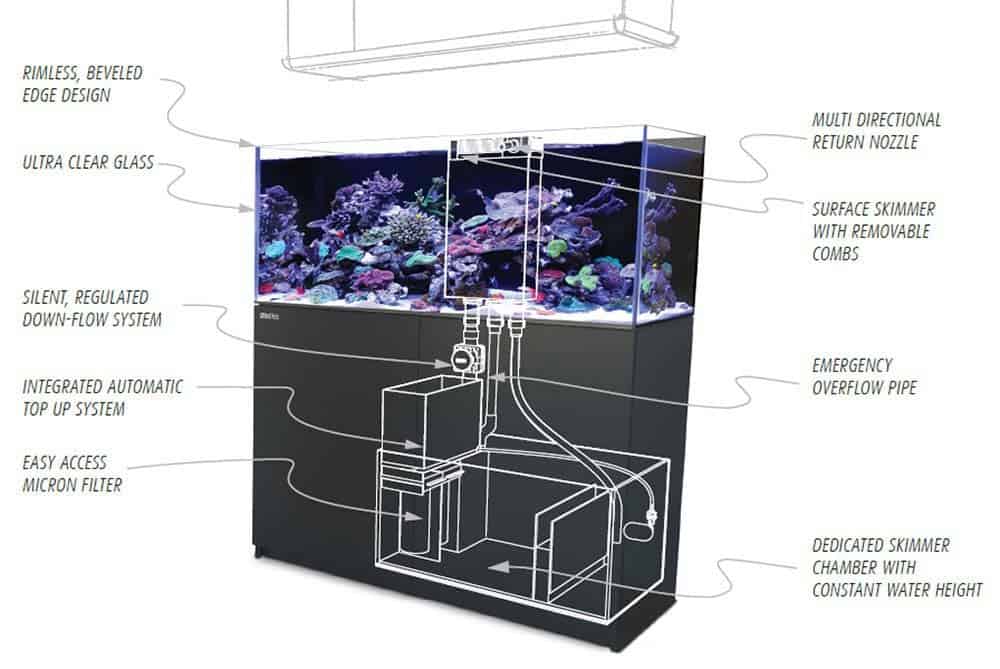
The primary benefits to adding a sump to your aquarium are:
Increased h2o book
Adding a 20g gallon sump to a 50gal aquarium has simply increased the total water volume by twoscore%! This tin really help keep h2o parameters more stable.
Hides Equipment
There is null worse than seeing a beautiful aquarium simply then be distracted by cables, pipes, and gadgets hanging off every wall in the tank.
Larger Equipment
Filtration equipment comes in many sizes and when y'all are limited to what size filter you tin can physically fit in/on the aquarium, it tin can shrink the product selection you accept to choose from. Having a sump allows yous a greater choice of filtration equipment.
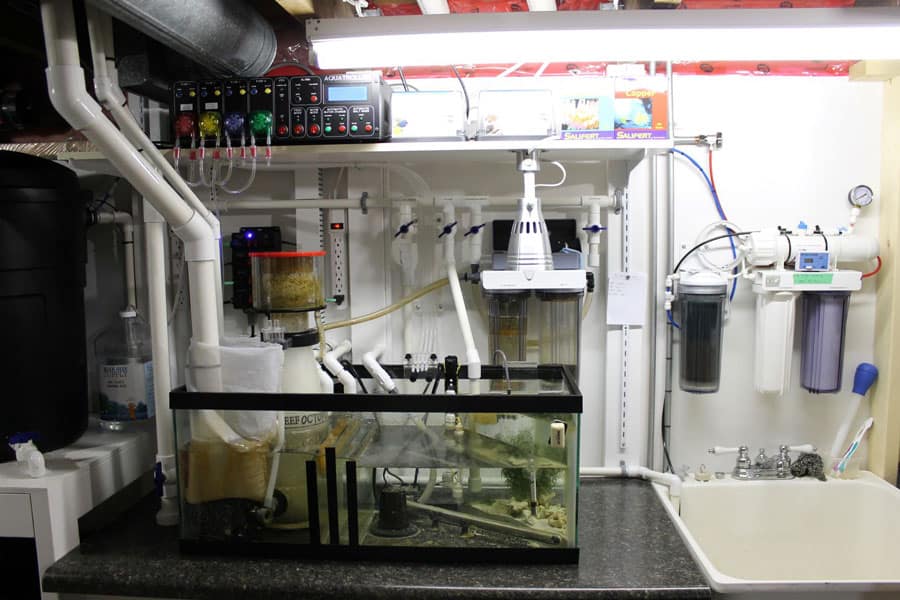
More Filtration
Having a sump allows yous more space to add additional filter media to assist control parameters like nitrates and phosphates. Chemic media can exist placed into mesh numberless or media reactors that can hang on the side of the sump.
Adding fabric to increment leaner surface areas similar MarinePure (Amazon.com) blocks can dramatically increase the biological load (bioload) the aquarium can now support = More livestock.
Algae Buster
A sump allows yous to install devices like Refugiums or Algae Turf Scrubbers to abound the algae out of sight rather than it growing all over your chief aquarium.
To assistance y'all understand more about what a sump is you tin can find a great selection of varying sized sumps to reference while you read through this article Here at Aquarium Specialty.com
So equally you can see a sump may non sound like much at first glance only the benefits far outweigh the cons and if you have not bought an aquarium yet or are thinking of an upgrade so an aquarium with a sump volition be ane of the best decisions you will make in this hobby!
How Do Aquarium Sumps Piece of work?
Sumps work past having water drain down from the primary aquarium via a weir and overflow department and into the sump. The h2o then passes through the filtration in the sump before being pumped back up to the main aquarium.
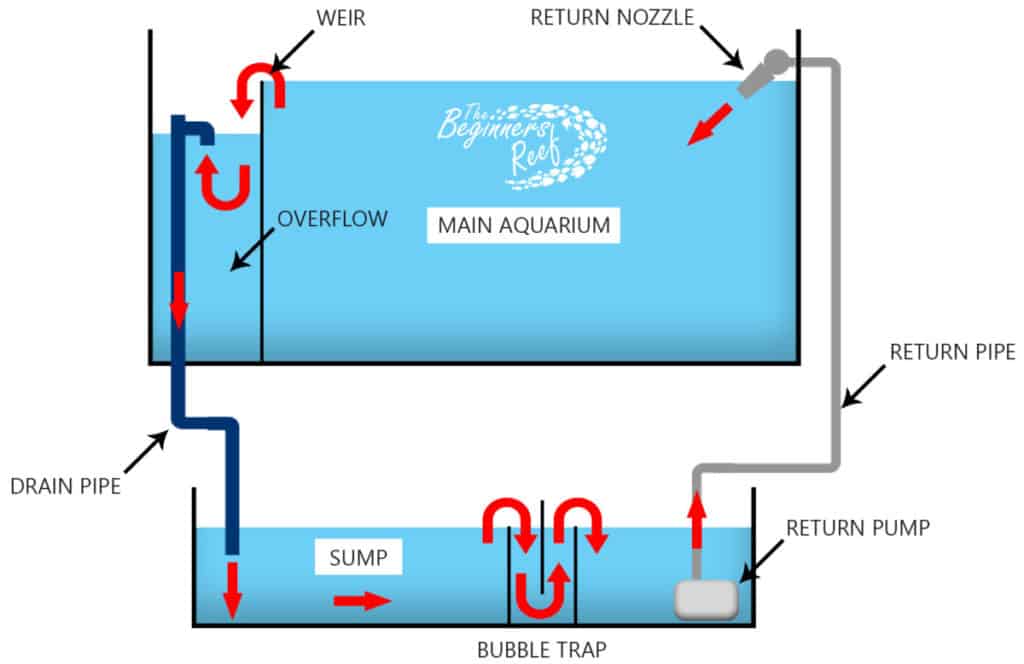
The apportionment of water never stops providing the 'Render Pump' is operating. Every bit the h2o gets pumped back into the main aquarium, it passes through a weir and drops into the overflow section. This is what keeps the water level in the main aquarium constant. It then drains into the sump and is then pumped dorsum to the main aquarium.
Think of this just like the overflow hole you see in every bathroom sink. When the water gets too high in the sink, it goes through the hole and down the drain pipage.
This is exactly how the aquarium/sump system works. Just instead of the h2o flowing out to the sewage treatment plant, it flows into a vessel under the sink, gets filtered, and pumped dorsum out of the faucet.
If you would like to find out more about how to size and select the correct Return Pump for your sump please be sure to check out my article: Aquarium Return Pumps – Pace Past Stride Selection Guide
What Are The Different Parts Of An Aquarium Sump?
Sumps can exist equally basic as a bare glass tank or can be custom machined from acrylic to do any the possessor wishes only nigh sumps have some common sections inside them to help improve the efficiency of how the sump works.
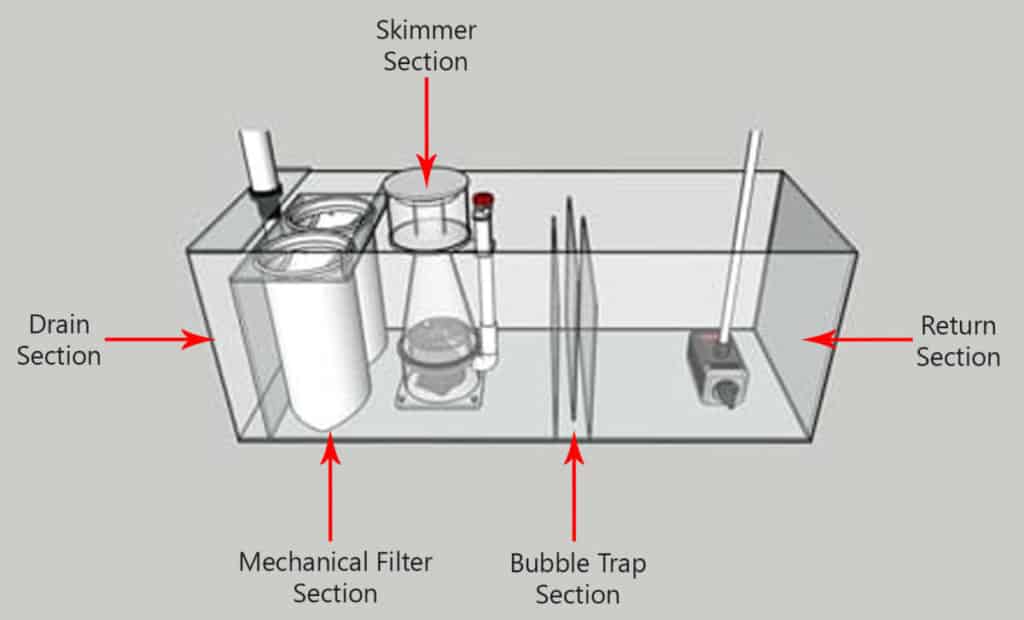
Drain Section
This offset department is where the water enters the sump from the main aquarium. There can be but a unmarried bleed pipe or multiple drain pipes collect in this surface area if the aquarium has 2 or 3 overflow sections.
Information technology tin either exist its ain covered department to prevent water splashing everywhere and creating salt buildup, or it is usually combined with the next section – The Mechanical Filter Section.
Mechanical Filter Department
The beginning part of the filtration that the water meets in the sump is the mechanical filters. These tin can be socks fabricated of filter fabric, sponge pads, mats made of filter floss, or a relatively new device that is taking the market place by storm – The Fleece Roller or Roller Mats as they are known.
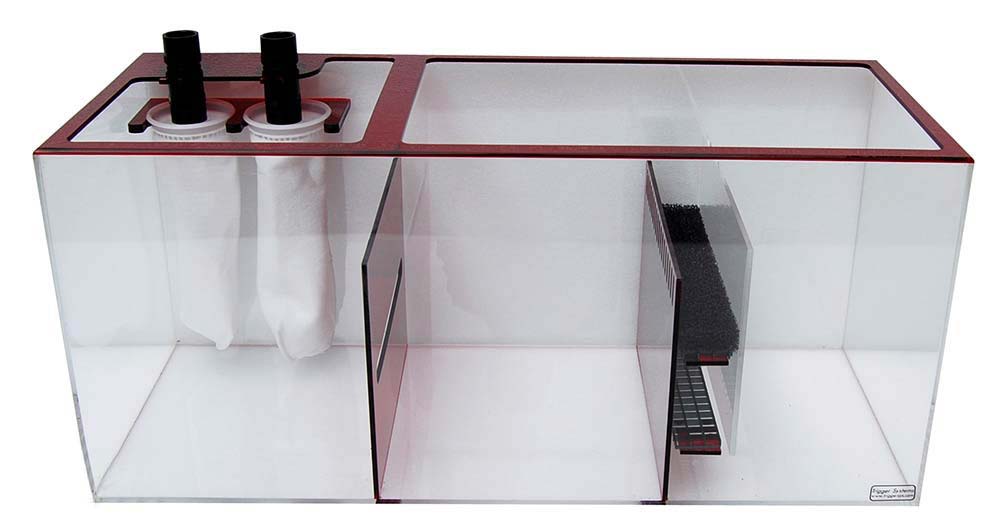
The principal job of the mechanical filter is to catch the big particulate matter suspended in the water so information technology can be removed before it gets chance to pause downwardly and disuse.
Skimmer Department
This section is more applicable to saltwater aquariums and is where the Protein Skimmer is placed. Once the big particles have been removed past the mechanical filter, the poly peptide skimmer gets to remove the Dissolved Organic Compounds from the water.
Protein skimmers accept a recommended h2o height that they must sit in and some sumps come with an adjustable wall on the Chimera Trap to let the owner to set the h2o level height in the skimmer department.
For those sumps that are unable to set the water level height, nigh aquarists make anxiety or a shelf to sit the protein skimmer on then it sits at the optimum recommended summit.
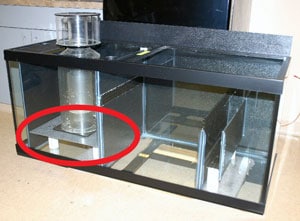
Bubble Trap
Bubbling are a big nemesis in saltwater aquariums. They are very popular in freshwater aquariums only we need to prevent them as much as possible in saltwater. Every bit the water drains into the sump and goes through the protein skimmer it becomes full of tiny microscopic bubbles.
Microbubbles can distress fish and coral and because of the strong lighting in a saltwater aquarium, they really show upward in the water cavalcade. Aquarists desire their water to be every bit pristine & articulate as possible and a bubble trap is a swell way to aid achieve this.
A chimera trap is a series of 3 baffles that trap bubbling and release them from the water. Equally the water cascades over the get-go baffle, its bubbling are released and travel upwards. The water then flows downwards and under the second baffle with virtually no bubbles in it. Whatever bubbles left are released as the h2o travels upwardly and over the third baffle.
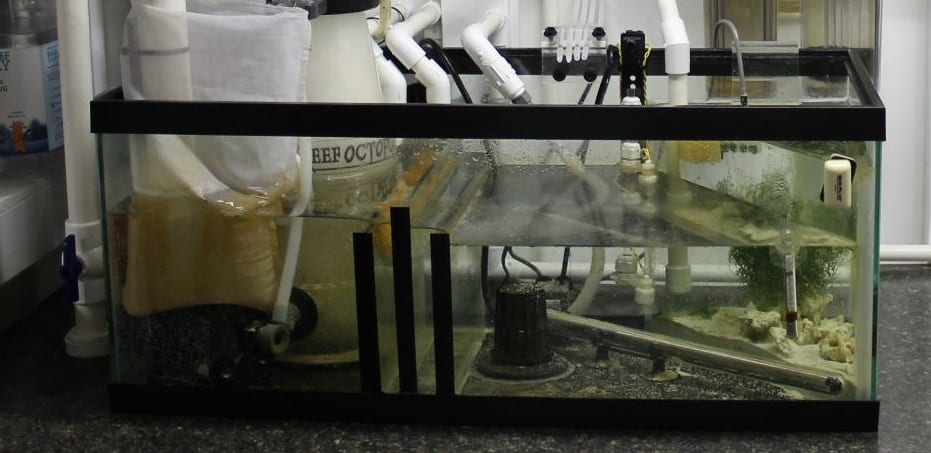
This simple device prevents whatsoever bubbling being sucked into the return pump and blown into the master aquarium.
Return Department
This section is where the Return Pump is located. The job of the return pump is to transport the h2o back up to the main aquarium so more h2o tin pass into the overflow and return to the sump to pass through the filters.
Pumps can either be a submersible blazon and sit within the water of this section or be an external pump and describe the h2o from this section.
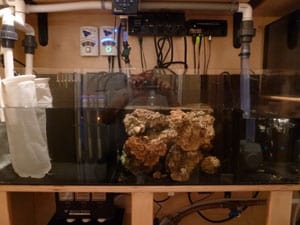
The important part every aquarist needs to know is that this is the section where the h2o level will decrease equally the aquarium water evaporates. If left unnoticed the water would drop until the pump runs dry which will cause the pump to fail.
The other major problem with h2o evaporating is that it leaves the salt backside, then as more than water evaporates the remaining water will go saltier equally the ratio of water to salt reduces.
To overcome these two problems ane of the commencement upgrades an aquarist will purchase is an Automatic Tiptop Off System. Y'all can find out all you need to know about ATO systems in my article: What Is An Aquarium Auto Top Off?
Additional Sump Sections
If y'all accept space where the sump is going to sit down or you wish to build your own custom DIY sump then there are two additional sections you tin install to brand the ultimate sump:
one. Refugium Section
A refugium is an surface area defended to growing macroalgae and allowing Copepods to grow without being eaten. Past growing macroalgae in this area, you can dramatically reduce the corporeality of phosphate and nitrates in your aquarium allowing for cleaner and healthier water.
For a far more in-depth look at Refugiums please take a await at my commodity on them: What Is A Refugium?
2. ATO Reservoir
In the return department of the sump, I mentioned how this is where evaporation occurs, and to keep stable water parameters we tin install an Automatic Peak Off organization to replenish the evaporation with freshwater.
This freshwater needs to come up from somewhere and unremarkably most people fill a 5-gallon pail with freshwater every week to keep the system working. Having a reservoir built into the sump keeps everything neat and tidy.
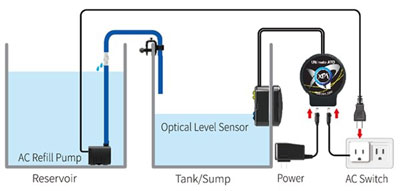
Are There Different Types of Aquarium Sump Design?
There are and so many designs of sump bachelor that y'all will have no problem finding 1 that fits your bachelor area or can accept all the sections y'all demand. If you lot are unable to find one and so you lot can build your own like I did or have 1 custom fabricated.
These adjacent designs will give you the basic layouts of the about common sumps bachelor.
The Well-nigh Bones Sump Design
The mechanical filter, skimmer section & return sections are all together – No baffles or bubble trap.
This is the simplest option only provides no way of removing any bubbles or keeping the water level a constant height due to evaporation of the whole section.
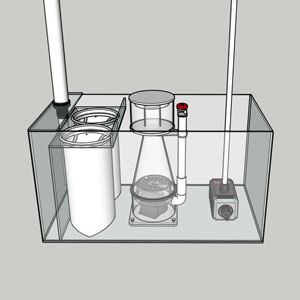
The Most Pop Sump Design
Mechanical filter section and skimmer section in 1 area and a chimera trap with a return department.
This allows the skimmer section tin can have a constant water meridian and the render section can be bubble free.
three simple glass or acrylic pieces are all that is required to improve on the Basic Sump Design
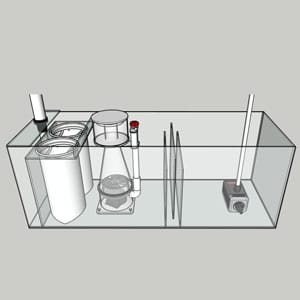
The Near Efficient Sump Design
Installing a sump with a built-in Refugium is a keen choice for those who can fit information technology. By Tee-ing off the return pipage the owner can install a valve to prepare the flow charge per unit through the Refugium to allow the mass of Macroalgae to plow.
The Refugium water and then cascades over a dividing baffle and back into the return department.
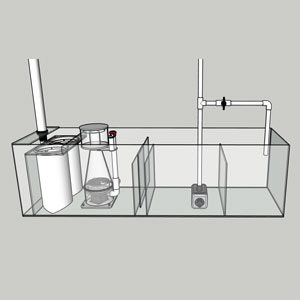
The Ultimate Sump Design
This design of sump adds an expanse for a ATO reservoir. Having 5-x gallons of freshwater available for the system means this surface area only has to be refilled once a week (depending on the tanks evaporation rate).
A solenoid valve on a timer or toilet-style float valve can let for this department to automatically remain filled too!
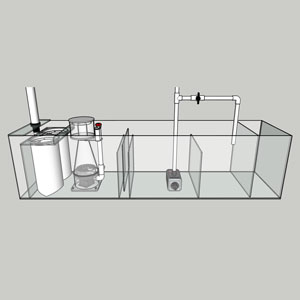
The Compact Sump Design
For those owners that have a Cube-Shaped aquarium or are tight on space, having a compact sump allows for all the efficiency of the larger sumps only in a more compact space.
These require a little more conscientious equipment selection to be able to fit in the sections and maintenance can exist a picayune tighter to work on, but overall a great type of sump!
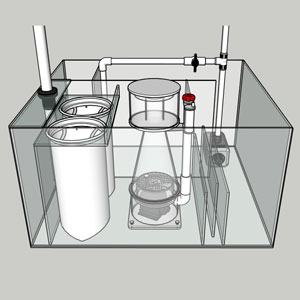
Where Do You Install an Aquarium Sump?
This department is broken down into ii parts:
- The overflow part of the aquarium/sump installation
- The physical location of the sump itself
The Aquarium Overflow
If yous have a sump, you demand a manner to become the h2o from the brandish tank downward to the sump. This is where a weir and an overflow come in.
The weir acts as a barrier to setting how loftier the h2o level is in the main aquarium. It usually contains teeth or grooves cutting into an acrylic sheet to preclude snails, crabs, and fish getting into the overflow section.
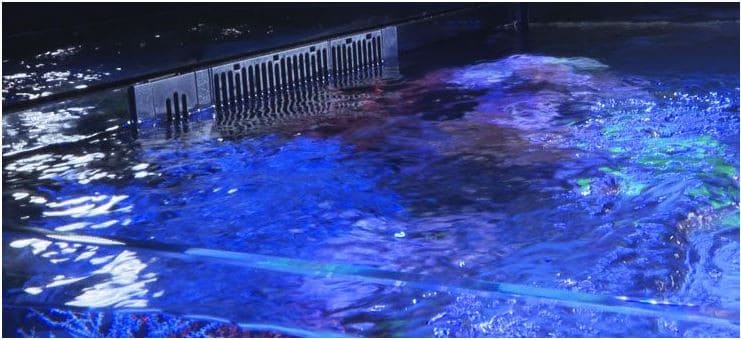
The weir also acts every bit a surface skimmer to pull any junk or droppings floating on the h2o surface into the overflow to exist taken to the filtration.
The overflow section is where the water collects afterwards cascading over the weir before inbound the drainpipe to run into the sump.
I accept seen and worked on many of the popular types and I'm going to guide you through each type:
Reef Ready – Drilled by Manufacturer
You tin can buy tanks pre-drilled from the manufacturer with a Drain Pipe, Return Pipe, and Overflow pre-installed. These are very good tanks and are very popular. Reasonably priced also.
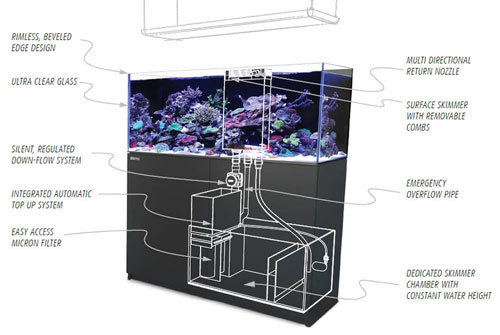
Internal Overflow – Drilled by Possessor/Store
This type of overflow is very popular with the DIY'er every bit it allows y'all to custom arts and crafts your tank to suit your habitation and prepare upwards. An internal overflow uses a box on the inside of the aquarium with a pigsty or holes drilled through the side pane to either a plumbing bulkhead (Durso Method) or some other box with which several bleed pipes can be fitted (Herbie & Bean-Animal Methods).
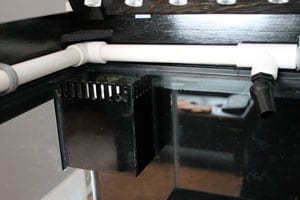
'Ghost' Internal Overflow
The Ghost Overflows are a great choice as they are very low contour with the minimum corporeality of box on the inside of the aquarium. They do disappear well into the back/side walls and will be my choice on my side by side aquarium. They come in various sizes and allow for multiple drain pipes making them silent in functioning (Bean-Animal Method).
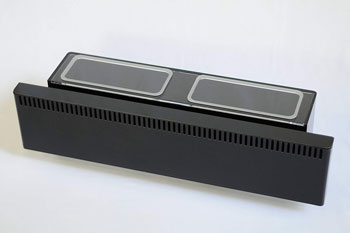
External Overflow – Custom Tanks
This type of overflow is as well very popular peculiarly if you lot are having your tank custom built. This overflow has the side/back pane notched out at the height to provide the exit for the water to fall into a collection box on the back of the aquarium.
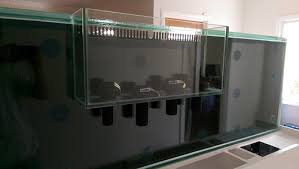
A black acrylic panel is then placed over the pane with teeth machined into it to keep critters out of the overflow. The simply part of this overflow you tin come across from the front is the teeth on the weir.
These are the all-time overflow in my opinion but price the most considering the drinking glass console has to exist machined and a glass box constructed on the exterior of the aquarium. You are able to fit whatsoever of the 3 drain styles into it (Durso, Herbie & Bean-Animal) making information technology super silent.
If you are having your aquarium custom built this is the overflow to choice!
Siphon Overflow!
I have left this overflow until final because, in my stance, they can create and then many headaches. They are for tanks that are not drilled. They provide a ways of moving water out of the display tank and downwardly to the sump by using a siphon.
They siphon water over the rim of the aquarium, collect it in a box and send it down the connected drain piping.
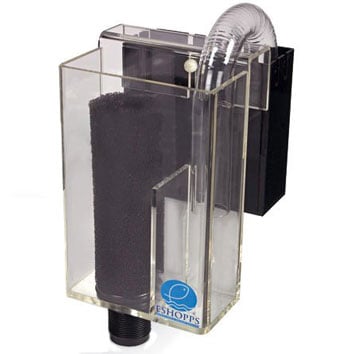
I cannot propose y'all plenty to stay abroad from these overflows . Just have your tank drilled or buy one drilled. They are piece of cake to drill!
This blazon of overflow has caused me more than problems on clients' tanks considering when you get a power outage, the siphon breaks, and sometimes the siphon starts on power-up, and sometimes it does not.
You tin can purchase a small pump that sits on superlative to suck water into the siphon, simply information technology's just a bandaid.
Many a tank has been flooded because the power comes back on, the return pump starts, but the siphon does not. The return pump then empties the contents of the sump into the display tank and information technology overflows!
Save yourself the headache and get a drilled tank if you desire a sump or an All-in-Ane Aquarium.
The Sump Location
At that place are three main locations that most aquarists install their sumps in their homes.
- Inside the Aquarium Stand
- Below the Aquarium in the Basement
- Backside the Aquarium in a Separate Room
i. Sump Within the Aquarium Stand
This is by far the nearly pop location for many aquarists due to the ease of plumbing and it is easily hidden away once the stand doors are closed.
There are some very, very nice sump installations in this world, and I'grand surprised at merely how much equipment tin can get crammed into a stand.
This is a typical fashion to install a sump in your system.
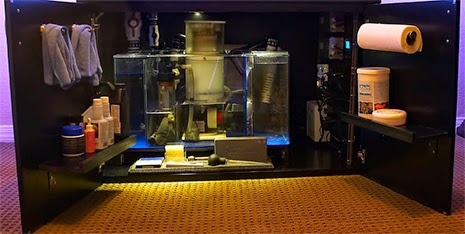
The convenience of this location is great but it comes with a few drawbacks:
- Express space to mountain additional equipment
- Electrical and Saltwater are within very close proximity to one another
- Difficult to motion equipment in and out for cleaning and maintenance
- You are on your knees leaning into the stand up – Trust me it hurts later a while!
two. Sump Below the Aquarium in the Basement
This is a swell selection if your home and budget allow for information technology. It doesn't cost that much more, only the benefits of having space and everything mounted at a nice working acme makes a huge divergence in doing maintenance.
This is my sump installation in my basement. I was fortunate enough to have access to the location straight nether my aquarium to build my 'Fish Area'. This allowed me great admission and the room to aggrandize and install a Quarantine Tank and a Frag Tank in the early years subsequently initial installation.
The just downside to this was I had to have a big return pump that was expensive, to push the water back upward the 13ft to the top of my Display Tank.
three. Sump Backside the Aquarium in a Split up Room
If your home and budget tin can accommodate this it is past far ane of the best installation methods you tin can do for the ultimate reef tank setup!
By placing the sump in a room backside the aquarium you lot have a make clean slate on how to blueprint the layout, the space to add as much equipment as you like, and room to add equipment later as your skills and tank progress.
The other good part well-nigh this is yous are not pumping water upwardly high, and then the caput pressure is greatly reduced allowing you to use a lower wattage return pump.
For More information on Head Pressure level and Selecting the Best Return Pump Click Here to read my article.
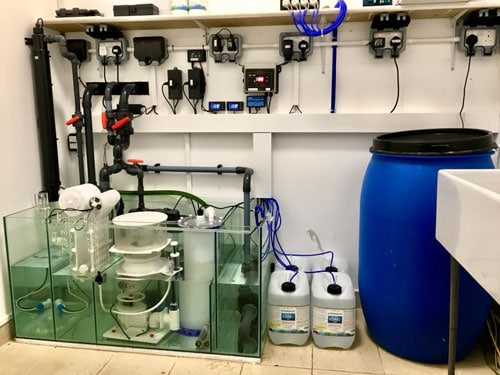
From a maintenance betoken of view this method is past far the best if your partner will allow y'all to convert a room into your 'Nerd Room'! Having access to a sink and existence able to plumb in your water storage tanks is worth its weight in gilded!
This may seem daunting but once you have spent some time on your knees under the stand up you will be planning your 'Fish Room' for your side by side build!
What Is The Recommended Menstruation Charge per unit Through An Aquarium Sump?
The principal purpose of the sump as we described earlier is to house equipment and provide greater h2o volume. The 2 main pieces of equipment that are installed in near sumps are the Protein Skimmer and Heater/southward. The thought is to notice a render pump that matches the recommended menses rate of the protein skimmer.
The protein skimmer will accept an optimum catamenia rate that it was designed for and most aquarists recommend anywhere from 3x – 5x your tank capacity through your sump every hour.
For Case:
My aquarium is 75 gallons so 3x volume per hour would be 75×3=225 gallons/hour (GPH) menses charge per unit.
My protein skimmer is designed to operate around 200GPH so here is where I began the search for which return pump to utilize.
My return pump gives effectually 800GPH at 12ft head height which is perfect for my setup considering my sump is located in the basement beneath my aquarium. I take a manifold running additional equipment so I'm able to throttle down my render to the tank with a valve so that the flow through the sump is around the 200GPH rate.
Do non become dislocated with the sump menstruum charge per unit and brandish tank menstruum rate. Your corals will need massive amounts of flow rate, but this is created using wavemakers or powerheads.
All your render pump is for, is to set the flow rate through your sump and return the h2o back to the brandish tank.
By having a wearisome period charge per unit through your sump, your water will get maximum contact fourth dimension with the Protein Skimmer and your Heaters/Chiller and let them to operate at their maximum efficiency.
Are There Whatsoever Aquarium Sump Installation Precautions?
The two main areas I accept seen cause problems with new sump installations autumn nether one of the following categories. By being aware of these precautions to take you can dramatically increase the chances of a mishap occurring with a new sump:
- Flooding Prevention
- Electrical Safety
Read on to find out how to keep prophylactic and prevent a huge mess!
Flooding Prevention
Being an aquarium owner, one of the biggest fears many people have is flooding, peculiarly with saltwater. If you take a flood with saltwater the damage tin be huge! Not merely does the water create problems but one time it dries the salt is left behind making a big job, even bigger.
Making your aquarium and sump every bit flood-proof as possible is an absolute must, so here are some things to be aware of and steps to take to forbid a flood:
Power Outages
Once you have a sump installed into your organization you have to make certain the operating h2o level in your sump is fix correctly.
During a ability outage, the water that is in the pipage going upwards to the tank from the return pump is going to drain back down into the sump. If your display tank is considerably college than the sump and you have a large diameter piping, you could take a lot of water draining back down.
Many people utilize a Non-Return Valve on the return pump to prevent this, but if that fails and your sump level is not correct, you volition flood.
To set upwardly your sumps operating water level I suggest this:
- Fill your sump to 50% full with the return pump running.
- Disconnect the power to the pump and permit the h2o dorsum bleed into the sump.
- Mensurate how much the water level in your sump rises. This now shows you how much gap you lot need to leave at the meridian.
eg: Back Drain amount rose sump water level past 4″ - Set normal operating water level to 6-7″ below the summit of your sump. ie: Water changes should refill back to this level and have your ATO set up at this level.
- Draw a line on the sump glass at the normal operating water level. This allows for quick glances to meet sump is at the correct level and your ATO is working properly.
Non-Return or Check Valves
If you have a strong desire to utilize a non-render valve that is OK. Just make certain you have your water level prepare correctly, or if y'all are unable to exercise the in a higher place pace because too much Dorsum Bleed water comes in, you then accept to apply an NRV (Non-Return Valve) if you lot cannot fit a bigger sump.
When you are selecting an NRV I would suggest using the valves that accept a flapper valve within of them, rather than a spring-loaded valve.
The flapper valves take a lot less pressure to open compared to the jump-loaded valves and this volition give you more than flow out to your display tank. You don't want to be spending coin on a expert return pump and have all its pressure taken away considering of a valve.
The other tip I recommend is spending a little extra coin and purchase the run into-through valves with the spousal relationship connections on each end. This way y'all can meet if they are working correctly and it also allows yous to see when it needs cleaning.
You will see an arrow molded into the side of the NRV. Make sure this isPointing Away from your return pump!
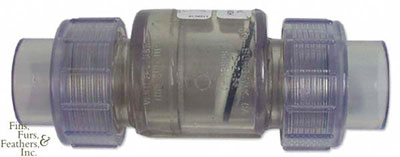
You can find these clear Check Valves Hither at Amazon.com
Next, install a ball valve between your NRV and Display tank, this way you tin isolate the h2o in the pipe to a higher place and easily remove the valve for cleaning.
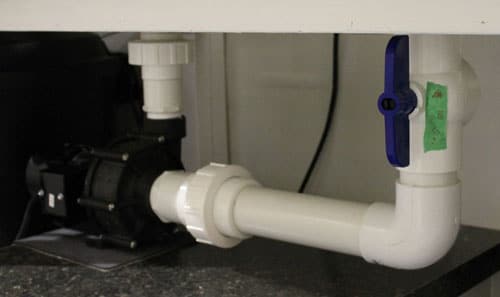
Cleaning is the primal to Non-Return Valves!
Improperly Sealed Aquarium Overflow
I have seen a few floors flooded due to an improperly sealed overflow in the brandish tank. Once the water drains out of the overflow in a power outage, the water in the display tank should non leak or creep into the overflow.
Be sure to always leak check your aquarium AND overflow (outdoors) for several hours before you properly install your aquarium, to make sure it is all watertight where it needs to be.
Having a modest leak into the overflow volition continue to drain down into the sump. Even if you lot have set up your sumps water level correctly, a slow leak over 8-10 hours will overfill your sump and overflowing the floor.
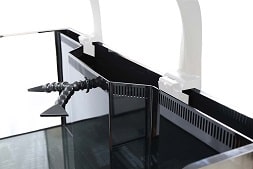
Leak Check Before Installation Saves Flooding!
Clogged Filter Socks or Filter Floss
In the early on weeks of your new aquarium be certain to go along an eye on how rapidly your mechanical filter socks/floss begin to clog upwardly with detritus.
Keep plenty of spare socks or floss on hand to supplant your clogged ones regularly. Once this filter becomes clogged it makes it harder for the h2o to pass through information technology.
As your livestock increase, your filters may clog faster, so continue an eye on them.
Depending on the blueprint of your sump you may not have a filter floss or sock water bypass in there to prevent a flood. I change my socks weekly, and so have some filter floss in my bubble trap. I only place floss in 3/4 of the width of the chimera trap to allow water to by-pass if information technology becomes likewise clogged.
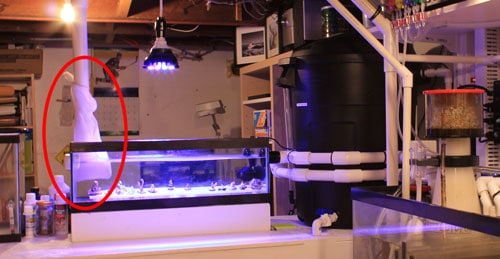
Ensure your filter socks are non nearly the border of your sump, so if the sock/due south do overflow, they dump the water into your sump and not out over the border.
Sump Overflow Drain
If you lot can exercise this information technology may salvage your Butt! When y'all design your system y'all should e'er be looking at simple ways to cover your rear end. Having an overflow drain in your sump is one of them if your location allows.
In my sump, I drilled and installed a i/two″ bulkhead nigh 1″ from the height of my sump, and so piped this into my house drain. This saved me from a overflowing when I plant out my aquarium overflow developed a pinhole leak and we had a ability outage 2 years after installation.
This is going to be a tough task for many people who have their sump located in the stand, and there is no basement access below or some class of house drain nearby, merely lower than the Overflow hole in the sump, but if y'all can, do it! Information technology is worth it!
Think of the Sump Overflow every bit an overflow hole in a typical sink.
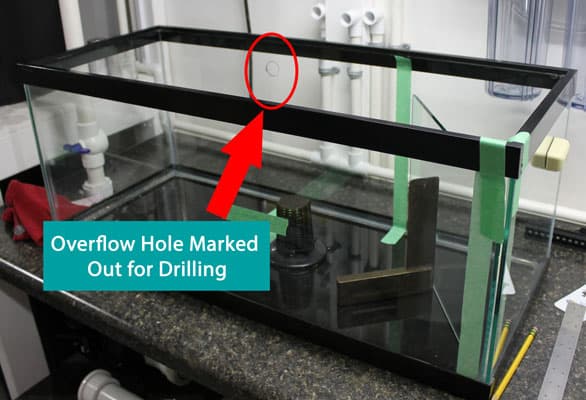
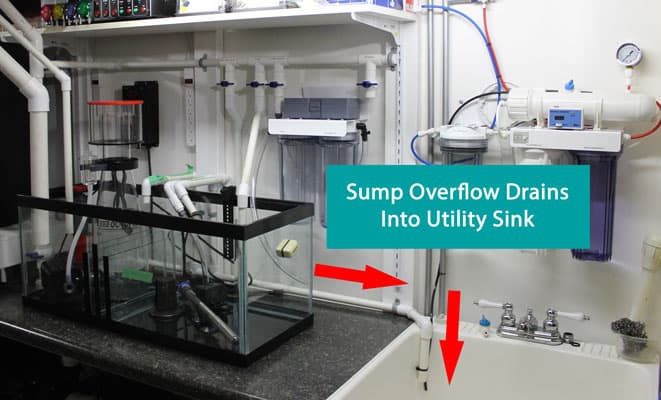
Water Alarms
There are 2 types I want to include here:
- Loftier Water Level Alarm
- Leak Detection/Flood Alert
These are lifesavers! I have both fitted to my aquarium via my DIY built controller and these alarms have saved me.
Every bit humans, we all make mistakes, forget to turn something back on, drink alcohol while doing maintenance etc and we forget!
You can buy or create your own elementary devices that can alert you direct away to a leak or an impending leak, and then y'all tin take action to foreclose any further mess.
Pretty much all the aquarium controllers available today have this role and you can as well have them shut down pumps, send y'all texts etc to aid preclude the chaos getting worse.
If you cannot beget a controller, you can buy a simple flood detection alarm that sits next to your sump and notifies yous that you accept water where you shouldn't.

This ane HERE at Amazon.com works bully by sounding an audible alarm and linking to an app on your smartphone to provide an alert if you are not home to hear it! Oh, and it's inexpensive! Please get one at the very least. Y'all will not regret it!
Electrical Safety
Electric safety with aquariums is absolutely paramount, ESPECIALLY with saltwater!
The two main hazards nosotros are looking at here are electrocution and fire and both of them need to be considered carefully on how to prevent both, ALL THE TIME.
Electrical Daze
If you have a faulty piece of equipment or an item falls into the sump while you are working in it, you are going to be in real trouble if y'all have not taken the following precautions. Saltwater peculiarly, conducts electricity and then well that you lot need to exist careful and practice the following steps:
- Ensure all equipment has baste loops in the cable
- If electrical sockets are close, encompass them with external weatherproof covers
- Ensure whatsoever electrical equipment is deeply fastened to the aquarium stand or similar
- Practise not remainder Refugium lite fixtures on the summit of the sump. Suspend them or use a fixing kit
- Beware of salt creep – Keep it cleaned off electrical items at all fourth dimension
- Unplug any detail while working on it
- Beware of water splashing on an electrical detail
- Keep a close eye on 'Glass Heaters', they can crevice and cause electrocution.
To farther aid in protecting you, accept your plug outlets replaced to GFCI receptacles. These are designed to monitor the items plugged into them and trip at the starting time sign of a fault.
If you cannot beget an electrician to supercede your receptacles you can use a GFCI Adapter that you plug into the wall.
This GFCI Adapter from Amazon.com is perfect for helping to go on you safety. Every bit with everything be certain to test the manual exam role regularly.
Many people mutter virtually GFCI breakers or receptacles tripping and causing a tank crash. If it is tripping at that place is a slice of equipment that is non working correctly and you need to further investigate.
Fire
Burn is the 2d major concern with electric safety. Every bit mentioned before, saltwater is very conductive to electricity and an improperly protected device could ignite when it fails and cause a fire.
Burn down can start in an aquarium stand and spread to the surrounding items.
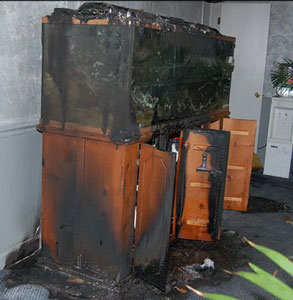
A adept tip I got told a few years ago and I all the same use it to this twenty-four hour period is to install a pocket-sized fume alert inside the stand of your aquarium or the ceiling of your fish room.
Early detection is essential for the protection of not only your aquarium but besides your home and family unit
If y'all wish to find out even more problems areas that can cause yous stress with your aquarium installation I highly recommend you have a read of this article I wrote: Aquarium Flood & Leak Prevention – 18 Problem Areas
Which Is Better – Aquarium Sump Or Canister Filter?
For many of you that have had an aquarium before you lot will be familiar with e the canister filter, but for those who are completely new to aquariums, a canister filter is a sealed canister that contains a pump that sucks water from your display tank, passes information technology through the various filter media to provide the cleaning and so returns the water back into the tank.
These type of filters are very popular in the freshwater aquarium hobby and they piece of work well. They are relatively like shooting fish in a barrel to maintain and are elementary to gear up.
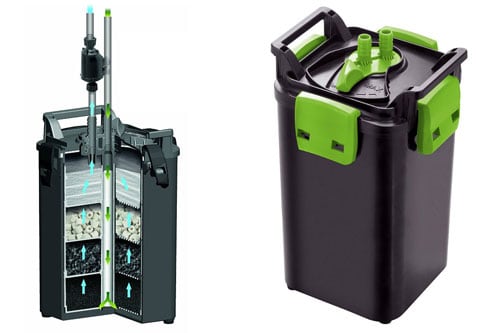
I would recommend these for a freshwater tropical aquarium but not for a saltwater aquarium. I have found that they can be easily forgotten as they get tucked away and then owners procrastinate in cleaning them.
This leads to high Nitrate levels from the detritus (waste & debris) building in the filter media.
To observe out more on Nitrate and the Nitrogen Bike Click Here to read my article.
The other principal problems with these are that you are limited to how much filter media they can agree and yous notwithstanding have to have some equipment in the display tank. Eg: Poly peptide Skimmer, Heater, Chiller (If required) Supplemental Media Reactors, Refugiums etc.
These are a practiced filter, but in my opinion for a freshwater tropical aquarium only.
You tin can find out more about using canister filters from my article: Can You Use A Canister Filter For A Reef Aquarium?
To Terminate
Well, there yous take information technology folks, pretty much everything I could think of that y'all would need to learn about installing a sump on your aquarium. Sumps are such a groovy addition and there is a reason when over 95% of saltwater aquarium owners apply ane and if you have a freshwater aquarium, information technology allows you to hide all of the equipment to allow the full beauty of the tank to be seen without lark!
Farther Reading
If y'all found this commodity helpful may I advise a few more for you:
- Poly peptide Skimmers: All you Need to Know!
- Selecting The Correct Aquarium Render Pump
- What Is An Aquarium Chiller?
- How To Select An RO/DI System For Your Aquarium
- Aquarium UV Sterilizers – What Do They Actually Exercise?


How To Set Up A Sump For Saltwater Aquarium,
Source: https://www.thebeginnersreef.com/aquarium-sumps-what-are-they-how-do-they-work/
Posted by: conleyknowded.blogspot.com


0 Response to "How To Set Up A Sump For Saltwater Aquarium"
Post a Comment